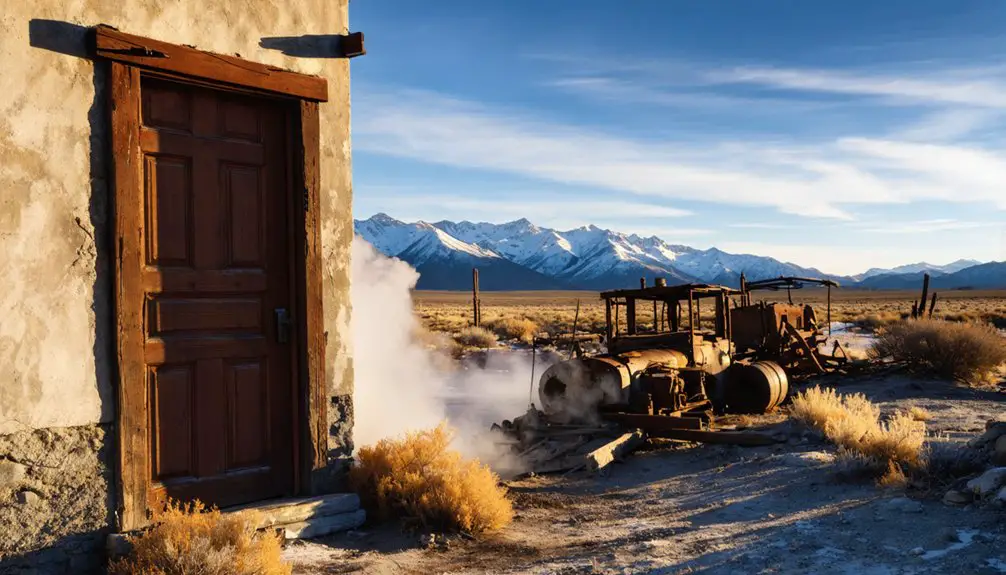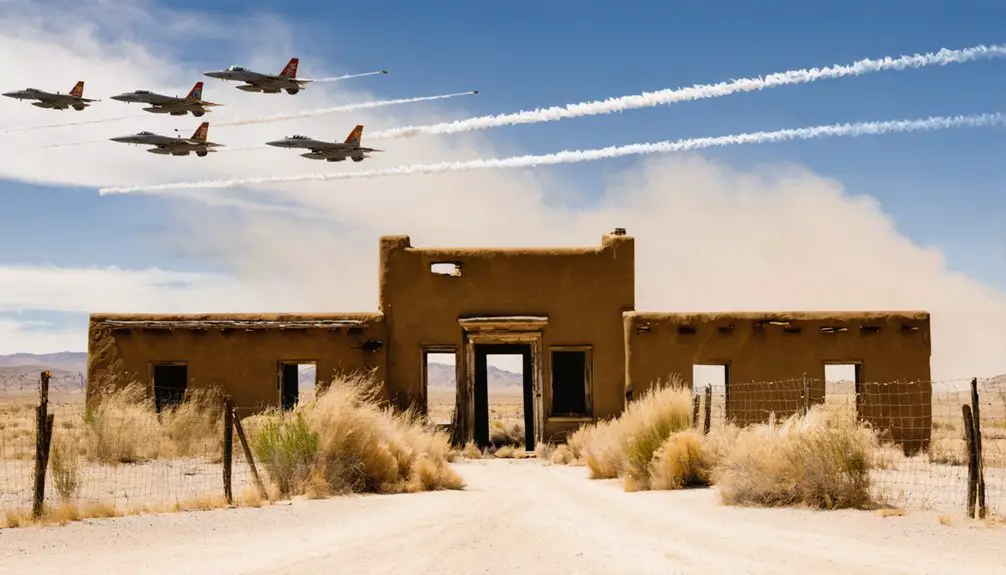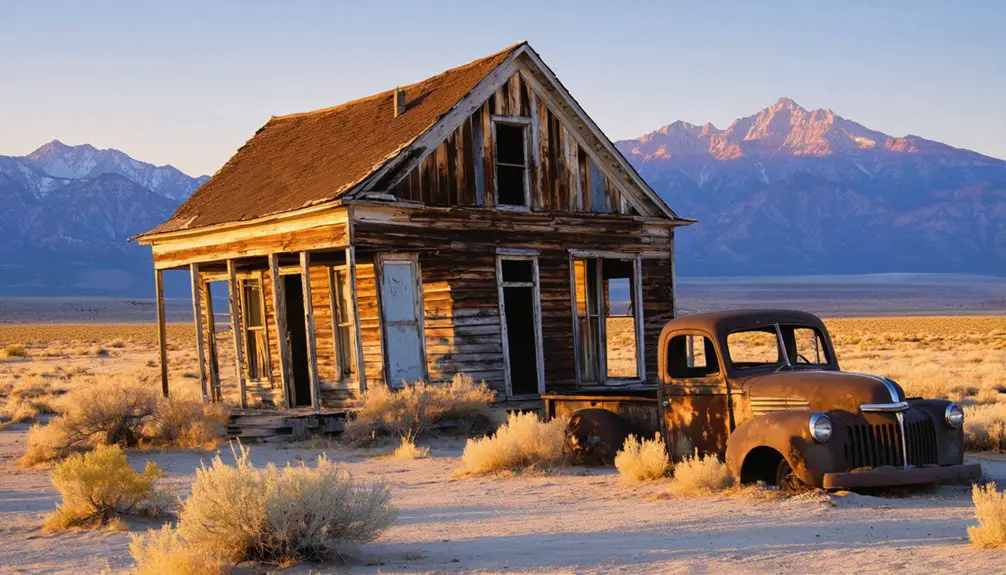You’ll find Dixie Valley 40 miles east of Fallon, Nevada – a ghost town with multiple lives. It began as a salt mining district in 1861, transformed into a silver boomtown, then became home to 50 ranching families who built a resilient community through the early 1900s. The U.S. Navy’s 1995 acquisition turned this historic settlement into a military training ground, leaving behind abandoned homesteads and a weathered schoolhouse that tell a complex story of Western frontier life.
Key Takeaways
- Dixie Valley transformed from a thriving ranching community into a ghost town after the U.S. Navy acquired the land in 1995 for military training.
- Originally established in 1861 for salt mining, the area later supported about 50 ranching families before military acquisition forced their displacement.
- The valley experienced multiple boom-bust cycles, including silver mining periods in 1861 and 1907, and gold mining until 1942.
- Remnants include abandoned homesteads, a weathered schoolhouse, and a “Cyanide Rocket Shop” built from recycled military containers.
- Located 40 miles east of Fallon, Nevada, the area now serves as military training grounds with restricted access and no available services.
The Salt Mining Origins
While Nevada’s mining history often centers on precious metals, Dixie Valley’s story began with salt extraction in 1861 when the Dixie Marsh District was established.
You’ll find the origins of this ghost town at the Humboldt Salt Marsh, a 9-square-mile expanse where pioneers extracted valuable minerals including salt, potash, and borax.
The salt you’d have mined here wasn’t destined for dinner tables – it played an essential role in the Washoe Process, a mining technique vital for silver ore treatment in boomtowns like Virginia City and Austin.
Salt extracted from Dixie Valley served a greater purpose – fueling Nevada’s silver rush through the crucial Washoe Process.
Records show that ten cars of borax were produced from the valley’s mineral-rich deposits during this period.
Despite harsh conditions, including scorching heat and hot underground water, determined miners used mule teams to transport their salt across vast distances.
Though the district’s heyday lasted only until 1868, it helped fuel Nevada’s larger silver mining economy.
The area was initially known as Osobb Valley before federal surveyors, changing its name when Confederate sympathizers arrived.
From Dixie to Marvel: A Town’s Identity
After the salt mining boom subsided, Dixie Valley underwent a remarkable metamorphosis in 1914 as ranching families arrived to establish a new community identity.
You’ll find the valley’s cultural heritage deeply rooted in this change, where about fifty families created a thriving ranching lifestyle that would span generations.
Unlike typical Great Basin terrain, Dixie Valley’s artesian wells nourished lush meadows, enabling these pioneers to build a resilient community.
Though they lacked retail businesses, they maintained their independence through a small schoolhouse and post office. Due to their remote location, residents lived 75 miles away from the nearest town.
The valley’s original name, derived from Confederate sympathizers in the 1860s, carried forward even as the community’s character evolved.
This transformation showcases remarkable community resilience, as families lived in isolation for up to 70 years before the U.S. Navy’s acquisition forever changed the landscape.
Today, the area is owned by Naval Air Station Fallon and contains ghostly remnants of the former community.
The Rise and Fall of Silver Mining
Despite its early focus on salt production, Dixie Valley’s mining history took a dramatic turn with silver discoveries in 1861.
You’ll find that this silver boom prompted rapid development, with La Plata becoming the initial mining county seat. However, by 1868, the excitement faded and settlements emptied.
The area’s mining legacy saw another surge in May 1907 when new silver deposits sparked renewed interest. Mining operations expanded to include cyanide extraction mills, reflecting the era’s technological advancement. French promoters from San Francisco attempted a town revival in 1911.
Within weeks, you’d have seen a bustling town of 200 residents, complete with saloons, stores, and hotels. Yet this revival proved short-lived.
The final significant chapter came with the 1934 Dixie Comstock mine discovery, which yielded $293,000 in gold and silver before closing in 1942.
Through each boom and bust, Dixie Valley’s silver mining ventures reflected the volatile nature of Nevada’s mineral rushes.
Ranching Life in the Valley
The hard work of ranching replaced mining as Dixie Valley’s economic cornerstone in the early 1900s. You’d find about 50 families settling the harsh desert landscape, adapting unique ranching techniques to survive. A notable pioneer family was led by Clyde Banus Stark, who moved from Sacramento to homestead 320 acres in the valley.
Each ranch depended on securing essential water rights through state-certified wells, which granted grazing privileges within a three-mile radius of each water source. Historical evidence shows that meat hooks were commonly used on juniper trees for butchering and preserving cattle.
To succeed, you needed to manage the alkaline soil through flooding and leaching while maintaining around 40 acres of cultivated land.
With roughly 100 artesian wells throughout the valley, ranchers could sustain their cattle across vast grazing areas. You’d have to plan carefully, stocking up on supplies during infrequent 75-mile trips to Fallon.
Despite the isolation, the community thrived through a self-reliant lifestyle, connected by their shared newspaper column and determination to tame the desert.
Military Acquisition and Forced Exodus
You’ll find the story of Dixie Valley’s transformation begins in 1995 when the U.S. Navy acquired the land, forcing approximately 50 families to abandon their homes and ranches.
The military’s need for a live-fire training zone near NAS Fallon meant there was little room for negotiation, leading to an abrupt exodus of the valley’s inhabitants.
Following the acquisition, the Navy demolished most structures and converted the valley into part of the Fallon Range Training Complex, where it continues to serve as a critical military training facility.
The facility’s history dates back to Western Defense Program operations in 1944, originally established to defend against Japanese attacks.
Today, the Top Gun training operations in the area regularly showcase military aircraft conducting low-altitude flight exercises over the former community.
During the 1980s, Dixie Valley underwent a dramatic transformation as Naval officials systematically acquired land from local ranchers and farmers to expand the Fallon Range Training Complex.
You’ll find that many residents were forced to sell their properties below market value, despite their fierce protests against the Navy’s expansion.
The community’s resistance drew national attention, including coverage from PBS and the Wall Street Journal, but ultimately couldn’t stop the military takeover.
Families Forced to Leave
As military acquisition plans unfolded, approximately 50 families faced an unprecedented upheaval from their established lives in Dixie Valley.
You’ll find their community resilience tested as the Navy’s land condemnation process forced these long-established ranching families to abandon generations of agricultural heritage dating back to 1861.
The historical memory of this tight-knit community was fractured as families scattered to nearby towns like Fallon.
You can still see remnants of their sudden departure – abandoned houses, a forgotten school bus, and ranch remnants stand as silent witnesses.
The military’s decisive actions didn’t just demolish buildings; they dismantled entire social and economic networks.
What was once a thriving ranching community transformed into restricted military grounds, erasing physical traces of a settlement that had weathered nearly 130 years of Nevada history.
Military Training Zone Conversion
When the U.S. Navy acquired Dixie Valley in 1995, they transformed the once-thriving community into a sophisticated military training zone.
You’ll find the valley now serves as a simulated hostile nation, complete with 37 radar systems and infrastructure mock-ups designed for military strategy development.
The conversion created distinct training areas: live-fire zones south of Highway 50, and non-live-fire sectors to the north.
You can still witness remnants of the past – an abandoned school bus, cyanide rocket shop, and scattered ranch buildings – amid the new military landscape.
The Navy’s emphasis on training realism led them to utilize the valley’s natural features, including artesian wells and vast open terrain, for tank maneuvers and close-to-ground aircraft exercises.
Today, this 80,000-acre expanse operates as part of the Fallon Range Training Complex, supporting Top Gun and other critical defense programs.
Natural Wonders of the Great Basin

The Great Basin’s extraordinary landscape offers visitors a remarkable array of natural wonders, from towering peaks to mysterious underground caverns.
You’ll find Wheeler Peak soaring to 3,962 meters, where ancient bristlecone pines, some over 5,000 years old, cling to windswept slopes.
The stunning Lehman Caves system stretches nearly 3 kilometers, showcasing rare cave shields and intricate formations dating back 515 million years.
As night falls, you’re treated to one of America’s darkest skies, perfect for viewing the Milky Way through public telescopes.
Crystal-clear alpine lakes like Stella and Teresa nestle beneath snow-capped peaks, while volcanic formations tell tales of ancient eruptions.
Whether you’re exploring U-shaped valleys carved by glaciers or watching wildlife in pristine mountain meadows, the Great Basin’s natural treasures await your discovery.
Remnants of a Lost Community
Hidden beneath the Great Basin’s majestic natural beauty lies a poignant story of displacement and change.
Behind vast desert vistas lies a bittersweet tale of communities uprooted and landscapes forever transformed.
You’ll find scattered remnants of Dixie Valley’s once-thriving ranching community – abandoned homesteads, a weathered schoolhouse, and an ingeniously crafted “Cyanide Rocket Shop” built from recycled military containers.
These physical fragments tell the tale of nearly fifty families who nurtured community memories here for generations, some calling the valley home for over 70 years.
Unlike typical ghost towns that slowly faded away, Dixie Valley’s story ended abruptly when the Navy claimed the land.
Today, military tanks rest where cattle once grazed, and the cultural legacy of this unique settlement survives in the few remaining structures, building materials, and personal artifacts that dot the restricted landscape.
Modern Military Training Ground

Since its transformation into a military facility, Dixie Valley has evolved into an essential component of the Fallon Range Training Complex (FRTC), spanning 790,825 acres of northern Nevada’s terrain.
You’ll find cutting-edge military technology throughout the complex, including 37 radar systems that create simulated hostile environments for advanced combat training.
What makes Dixie Valley unique is that you can still access its 270,000 acres, unlike other restricted FRTC areas.
The training evolution here supports everything from Top Gun pilot instruction to SEAL team preparation. You’ll witness carrier air wings with over 60 aircraft conducting pre-deployment exercises, while ground forces engage in tactical mobility drills.
The complex’s sophisticated TACTS system enables integrated combat scenarios, ensuring America’s warriors maintain their fighting edge in realistic battlefield conditions.
Access and Exploration Today
Located approximately 40 miles east of Fallon, Nevada, Dixie Valley beckons adventurous explorers willing to navigate its remote terrain.
You’ll reach the site via US 50 East, following Dixie Valley Road (SR 121) north and Settlement Road east for roughly 4 miles. While some access routes don’t require full 4WD, your vehicle should have high ground clearance for the unpaved roads.
Before exploring the abandoned ranches, military relics, and natural springs, verify which areas are open to the public, as the U.S. Navy actively uses portions of the land.
You’ll need to be entirely self-sufficient – there aren’t any services available. Pack essential supplies and follow key exploration tips: stay clear of unstable structures, avoid military zones, and watch for hazards like old mine shafts in the surrounding area.
Frequently Asked Questions
Are There Any Documented Paranormal Activities or Ghost Sightings in Dixie Valley?
Despite 100% of investigated sources showing no official records, you won’t find documented ghost encounters or spectral legends here – just natural sounds, military activity, and wildlife that create an eerie atmosphere.
What Happened to the Families Who Were Forced to Relocate?
You’ll find that most families scattered to nearby towns like Fallon, facing major lifestyle changes and community disruption. Their relocation impacts included lost ranching livelihoods and broken generational ties to the land.
Between a rock and a hard place, you won’t find exact property compensation figures from Navy negotiations, but records show they paid fair market value through “just compensation” legal requirements.
Were Any Movies or Television Shows Ever Filmed in Dixie Valley?
You won’t find any film history or documented television productions in this location. Despite its intriguing ghost stories, the area’s restricted military status has prevented it from becoming a filming destination.
Can Visitors Collect Artifacts or Minerals From the Abandoned Mining Sites?
You can’t legally collect artifacts or minerals here due to strict mining regulations and artifact preservation laws. Since it’s on Navy land, you’ll face penalties for unauthorized collection or trespassing.
References
- https://nvtami.com/2021/04/28/dixie-valley-tanks-and-taquitos/
- https://outerrealmz.com/dixie-valley-a-very-different-kind-of-ghost-town/
- https://www.nvexpeditions.com/churchill/dixie.php
- https://forgottennevada.org/sites/DixieValley.html
- https://forgottennevada.org/sites/bernice.html
- https://www.churchillcountynv.gov/DocumentCenter/View/15536/2020-Master-Plan-Appendix-E-List-of-Historic-Sites-in-Churchill-County
- https://adventuretaco.com/hand-me-the-binos-i-think-thats-a-tank-connect-the-dots-2/
- https://nevadamagazine.com/issue/may-june-2019/10064/
- https://landtransfer.us.com/products/the-20-66-acre-historic-dixie-mine-in-the-middlegate-mining-district-of-nevada
- https://en.wikipedia.org/wiki/Silver_mining_in_Nevada



